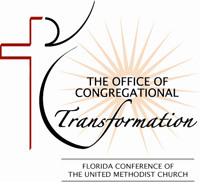 |
Congregational Transformation |
 |
Congregational Transformation |
|
Categories of Congregations
The Office of Congregational Transformation (OCT) There are FIVE CATEGORIES of congregations. The reason for establishing the categories is to focus congregational attention on assessment of their effectiveness in disciple making in light of the Great Commission (Matthew 28:16-20) and the Great Commandment (Matthew 22:35-40) The categories are defined in terms of congregational ministry orientation, i.e. the blend of outward and inward focus in ministry. Outward focus is directing ministry to the spiritual growth and needs of non or nominally religious persons in the community. Inward focus is directing ministry to the spiritual growth and needs of members. Each congregation discovers the category consistent with their current ministry focus by means of the Congregational Category Survey done annually. In 2003, 2004 and 2005 the Surveys were to be submitted in the fall of the year. Beginning in January, 2006 congregations will submit their Survey results as a part of the Annual Year-end Report. The Survey differentiates the categories of Transforming, Maintaining, and Dying by yielding a numeric score, 10 minimum and 50 maximum. Transforming congregational are those scoring 40 to 50, Maintaining 21 to 39, Dying 10 to 20. The Director of New Church Development makes the determination of which churches are Beginning and Reproducing. Congregations given these two category designations will still take the Survey to find their place on the Category scale as Transforming, Maintaining, or Dying. The results are submitted to the OCT for inclusion in The Category Table, which is the compilation of the category determinations of all Florida UM congregations. The Table, kept current by the OCT, will be used by the Cabinet in appointment making, in assisting the congregations, and in measuring the progress toward faithful obedience to the Great Commission by our Annual Conference. The Table is not confidential. Each year’s results can be seen on the Conference web site. Congregations will be entered into the Table each year as they submit their survey results. Those who have not yet submitted their results therefore will not be in the Table. CATEGORY DEFINITIONS
v
BEGINNING (creating or reclaiming a healthy balance of inward
and outward focus)
v
TRANSFORMING (a healthy balance of inward and outward focus) Healthy congregations are transforming ones and expect to be so on into the future. Their numbers will increase over time.
v
REPRODUCING
v
MAINTAINING (primarily inward focused)
v
DYING It is important to note that a congregation’s category is almost entirely a matter of its own choice. The congregation chooses the focus of its ministry, whether it is inward or outward and in what balance. So, no matter what category the Survey says a congregation is, by their own choice of a new Great Commission vision and passionate hard work they can become Transforming. That is what the golden circle on the graphic below portrays. Other Definitions: The terms “mission,” “new church,” and “exploring” are not properly categories. “Mission” and “new church” describe stages of development in the new church start process. Neither of the three are descriptive of ministry orientation. Here are their definitions: Mission
Some may never become a church. Mission congregations are supervised by the Conference Committee on New Church Development and/or the District’s corresponding committee.
New Church
New Churches are likely, but not automatically, to be transforming as a natural result of being a newly formed faith community. They may invite OCT to help them remain so. They continue with mentoring by the Director of New Church Development.
Exploring
A Maintaining congregation may “explore” becoming a Transforming congregation. A Transforming congregation may “explore” becoming a Reproducing one. Similarly, the reverse is also be true. By inattention to the continuous need for transformation a Reproducing congregation or a Transforming one may settle back into Maintaining, or a Maintaining one to Dying.
Help from the OCT
The OCT will lead all congregations to consider how transformation may benefit them, without regard to their participation in the Category Survey. The OCT will spend its resources in support of the mission for which it was created, transformation.
Return to Congregational Transformation home page
|